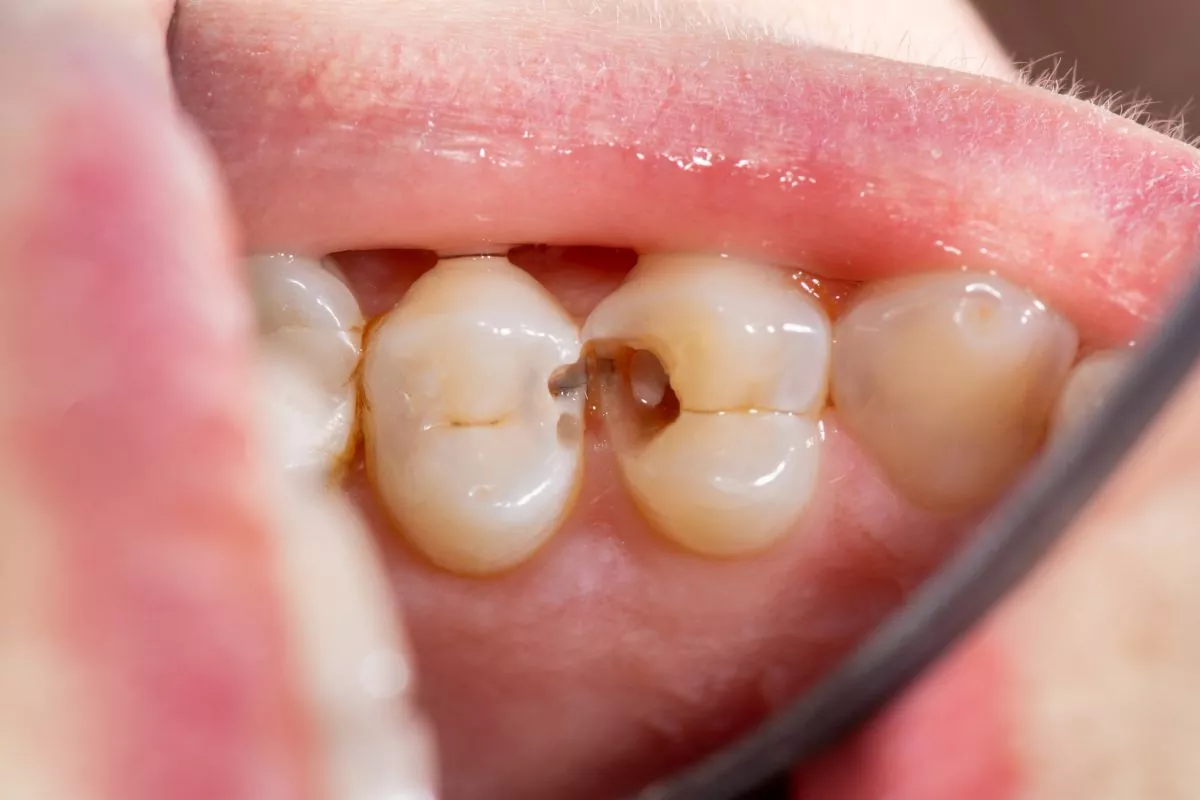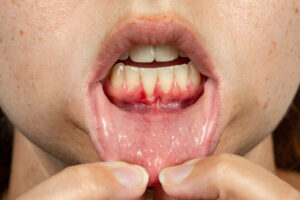Cavity in Between Teeth – Causes and Treatment

Cavities are widespread dental issues, with the vast majority of individuals experiencing at least one by the time they reach adulthood. Astonishingly, statistics reveal that 92% of U.S. adults between the ages of 20 and 64 have encountered cavities in their permanent teeth.
But were you aware that cavities can also form in the less visible spaces between your teeth?
Known as interproximal cavities, these occur when enamel erosion allows bacteria to adhere to and decay the tooth. Continue reading to discover the key indicators of a cavity lurking between your teeth and learn effective strategies to prevent their occurrence.
Table of Contents
Is it Possible to Get a Cavity in between Teeth?
Yes, it is entirely possible to get a cavity in between your teeth. These types of cavities, known as interproximal cavities, occur on the surfaces between adjacent teeth where they touch each other.
Because these areas are harder to clean with regular brushing alone, they can become prime spots for plaque accumulation and decay if not properly tended to with flossing or the use of an interdental cleaner.
Why It’s Possible to Get Cavities Between Teeth
Getting cavities between teeth, also known as interproximal cavities, is not only possible but relatively common for several reasons.
These areas are particularly susceptible to decay due to their unique position and the challenges they present in daily oral hygiene routines.
Here’s why cavities can easily form in these spaces:
- Limited access for cleaning: The tight spaces between teeth are difficult to clean effectively with a toothbrush alone. This makes it challenging to remove all the plaque and food particles that accumulate in these areas, providing a breeding ground for bacteria.
- Plaque accumulation: Plaque, a sticky film of bacteria, constantly forms on the surfaces of your teeth. When plaque is not removed through proper brushing and flossing, the bacteria in plaque can produce acids that erode the tooth enamel, leading to cavities.
- Inadequate flossing: Many people neglect flossing or do not floss correctly. Flossing is essential for removing plaque and food particles from between the teeth and under the gumline, areas where a toothbrush can’t reach.
- Dietary habits: Frequent snacking on sugary or starchy foods and drinks can lead to a higher risk of cavities. When these substances are consumed, the bacteria in the mouth feed on them and produce acids that attack the tooth enamel.
- Enamel erosion: The enamel on the sides of the teeth can be thinner than the enamel on the front and back surfaces. This makes the sides of the teeth more vulnerable to acid attacks and decay.
- Fluoride exposure: Tooth surfaces that are not exposed to adequate fluoride, which helps to remineralize enamel and prevent decay, may be more susceptible to cavities. Interproximal areas might not receive as much fluoride from toothpaste and mouth rinses because they are harder to reach.
Preventing cavities between teeth requires diligent oral hygiene, including regular brushing with fluoride toothpaste, daily flossing, reducing sugary and acidic food and drink intake, and regular dental check-ups for professional cleanings and examinations.
Signs You Have a Cavity Between Your Teeth
Detecting a cavity between your teeth, can be more challenging than spotting one on the surface of a tooth because they are not visible to the naked eye.
Some several signs and symptoms may indicate the presence of a cavity in these hidden areas.
- Tooth sensitivity: If you experience sensitivity or pain in your teeth when consuming hot, cold, sweet, or very acidic foods and drinks, it could be a sign of a cavity forming between your teeth.
- Floss tearing: If your floss consistently tears or frays when you use it between certain teeth, it might be catching on the rough edge of a cavity.
- Bad breath or taste: Persistent bad breath or a bad taste in your mouth, despite good oral hygiene, can be a sign of decay caused by bacteria in a cavity.
- Visible holes or dark spots: In some cases, if you look closely using a mirror, you might be able to see a hole or a dark spot on the side of a tooth that indicates a cavity.
- Pain when biting down: Pain or discomfort when biting down or chewing can be a sign that decay has penetrated the enamel and is affecting the dentin or even the tooth’s nerve.
- Bleeding gums: While bleeding gums are more commonly associated with gum disease, they can also occur near a cavity, especially if the decay is close to the gum line.
- Swelling: In more advanced cases, swelling of the gums around the affected tooth may occur, indicating a possible cavity or even an abscess.
Please remember that in the early stages, interproximal cavities may not present any symptoms at all. This is why regular dental check-ups, which typically include X-rays, are important for detecting cavities between teeth before they become more serious.
How to Find a Cavity Between Two Teeth
Finding a cavity between two teeth, also known as an interproximal cavity, can be challenging because these cavities develop in areas that are not easily visible without the use of dental X-rays.
Some methods can help you suspect or identify the presence of a cavity in these areas. Here’s a guide on how to find a cavity between two teeth:
Look for Visual Signs
Although it’s difficult to see between teeth, sometimes you can spot signs of decay if the cavity has progressed. Use a mirror to check for any discoloration or dark spots on the sides of your teeth.
Pay Attention to Symptoms
- Sensitivity to Sweet, Hot, or Cold Foods and Drinks: If you notice a sudden or increasing sensitivity, it could be a sign of a cavity.
- Pain or Discomfort: Pain when you bite down or a constant ache could indicate decay between teeth.
- Flossing Difficulties: If your floss tears or gets stuck in a specific spot, it might be due to a cavity creating a rough edge.
Use Dental Floss
Regular flossing can help you detect rough spots between your teeth where cavities might be forming. If the floss shreds or catches in certain areas, it could indicate a problem.
Dental X-Rays
The most definitive way to find a cavity between two teeth is through dental X-rays performed by a dentist. X-rays can show decay developing in areas that are not visible to the naked eye.
Use of Disclosing Tablets
Disclosing tablets, which you can chew after brushing, highlight areas of plaque accumulation with a temporary dye. While they don’t directly show cavities, they can indicate areas where you’re more likely to develop decay if the plaque isn’t removed properly.
Sensitivity to Flossing
If you experience pain or excessive sensitivity specifically when you floss between certain teeth, it might indicate a cavity or the start of one.
How is a cavity between teeth filled
The process is somewhat similar to filling cavities on other parts of a tooth but with specific steps to address the unique challenges of the location.
Here’s a general overview of how a cavity between teeth is filled:
- Diagnosis and X-rays – The dentist will start with a thorough examination, which usually includes X-rays, to determine the extent of the decay between the teeth.
- Anesthesia – To ensure comfort during the procedure, the dentist will apply a local anesthetic to numb the area around the affected teeth.
- Isolation of the area – The dentist may use a rubber dam or other isolation techniques to keep the area dry and free from saliva during the procedure.
- Decay removal – Using dental drills or laser dentistry tools, the dentist will carefully remove the decayed portion of the tooth. Precision is key to removing all decay while preserving as much healthy tooth structure as possible.
- Cleaning – After the decay is removed, the space is cleaned to eliminate bacteria and debris, preparing it for the filling material.
- Filling material placement – The choice of filling material can vary, including composite resins (tooth-colored fillings), dental amalgam (silver fillings), or other materials suitable for the location and extent of the decay. For cavities between teeth, composite resins are often preferred for their aesthetic qualities and ability to bond directly to the tooth structure.
- Shaping and polishing – The filling material is then shaped to match the natural contours of the tooth, ensuring that it fits well with the bite. Once the filling is properly shaped, it is polished to smooth the surface and prevent wear and staining.
- Bite check – The dentist will ask you to bite down on a special paper to check the bite and make sure the filling is not too high or interfering with your bite. Adjustments are made as necessary.
After the procedure, the dentist will provide instructions on how to care for your filled tooth and manage any sensitivity or discomfort, which should subside in a few days.
How to Prevent Cavities
Preventing cavities is key to maintaining good oral health and avoiding the need for fillings or more extensive dental work.
Here are effective strategies to minimize the risk of developing cavities:
- Maintain good oral hygiene: Brush your teeth at least twice a day with fluoride toothpaste. Fluoride helps to remineralize tooth enamel and prevent decay. Don’t forget to brush your tongue to remove bacteria and freshen your breath.
- Floss daily: Flossing once a day helps remove plaque and food particles from between the teeth and under the gum line, areas your toothbrush can’t reach.
- Use mouthwash: An antimicrobial mouthwash can help reduce plaque and remove remaining food particles that brushing and flossing may have missed.
- Eat a balanced diet: Limit sugary and acidic foods and beverages, as they can erode tooth enamel and promote cavity formation. Instead, eat plenty of fruits, vegetables, and foods high in calcium and phosphates to strengthen teeth.
- Drink plenty of water: Water helps to wash away food particles and bacteria. Fluoridated water also adds an extra layer of protection by helping to remineralize the teeth.
- Chew sugar-free gum: Chewing sugar-free gum, especially those with xylitol, can help stimulate saliva flow, which naturally cleanses the mouth and neutralizes acids produced by bacteria.
- Visit your dentist regularly: Regular dental check-ups and cleanings are essential for preventing cavities and catching any potential issues early. Your dentist can also apply sealants and fluoride treatments for added protection.
- Consider dental sealants: Dental sealants are a protective coating applied to the chewing surfaces of the back teeth (molars), where decay occurs most often. Sealants can protect these vulnerable areas from cavities.
- Be mindful of snacking: Frequent snacking can provide constant fuel for bacteria, leading to increased acid production and a higher risk of cavities. If you do snack, choose healthier options and rinse your mouth with water afterward.
- Protect your teeth during sports: If you play sports, consider using a mouthguard to protect your teeth from injury and potential cracks where bacteria can enter and cause decay.
What Options Do I Have to Treat a Cavity Between Teeth?
Treating an interproximal cavity involves professional dental care aimed at removing the decay and restoring the tooth’s health. Here are the primary treatment options:
Dental Fillings
The most common treatment for a cavity between teeth is a dental filling. The dentist will remove the decayed material and fill the space with a filling material, such as composite resin (tooth-colored fillings), amalgam (silver fillings), gold, or ceramic.
Composite resin is often preferred for its aesthetic appeal and because it bonds well with the tooth structure.
Dental Crowns
If the cavity is large and has compromised a significant portion of the tooth, a filling might not be sufficient. In such cases, after removing the decay, the dentist may cover the tooth with a crown (cap) made of porcelain, metal, porcelain fused to metal, or composite resin to restore its shape, size, and function.
Inlays and Onlays
Inlays and onlays are indirect restorations used when the cavity is too big for a filling but not severe enough to require a crown.
Made in a dental lab from gold, porcelain, or composite material, inlays and onlays are bonded to the cleaned-out cavity. An inlay fits within the cusps of the tooth, while an onlay covers one or more cusps.
Root Canal Therapy
If the decay reaches the tooth’s pulp (the center part containing nerves and blood vessels), it can cause infection and pain. In such cases, root canal therapy may be necessary.
This procedure involves removing the infected pulp, cleaning and disinfecting the inner chambers of the tooth, and then filling and sealing them. A crown is often placed afterward to protect the tooth.
Tooth Extraction
In extreme cases where the tooth is severely decayed and cannot be saved, extraction may be the only option. After removing the tooth, the dentist can discuss replacement options, such as dental implants, bridges, or partial dentures, to restore function and aesthetics.
FAQ on Cavity in Between Teeth
Can you fix a cavity between teeth?
Yes, a cavity between teeth can be fixed using various dental treatments depending on the severity of the decay. Options include dental fillings, crowns, inlays and onlays, or root canal therapy if the decay reaches the tooth’s pulp. In extreme cases, tooth extraction may be necessary.
Do cavities in between teeth hurt?
Cavities between teeth can hurt, especially as the decay progresses and gets closer to the nerves inside the tooth. Early on, you might not feel pain, but sensitivity to hot, cold, or sweet foods can occur. If left untreated, the discomfort can escalate to persistent pain.
How long does it take to fill a cavity between teeth?
Filling a cavity between teeth typically takes about 30 minutes to an hour, depending on the cavity’s size and location, as well as the specific treatment steps required.
How long can a cavity go untreated?
Leaving a cavity untreated can lead to more serious dental issues over time. While there’s no set timeline for when complications will arise, decay can progress to affect deeper layers of the tooth and potentially lead to pain, infection, and tooth loss if not addressed promptly. It’s best to treat cavities early to avoid more complex and costly treatments
When is a cavity too bad to fix?
A cavity is considered too bad to fix when the decay has extensively damaged the tooth structure, reaching deep into the pulp or compromising the tooth’s integrity. At this stage, options like fillings or crowns may no longer be viable, and a root canal or tooth extraction might be necessary.
How bad does a cavity have to be to get pulled?
A tooth needs to be pulled when a cavity has caused extensive damage that compromises the tooth’s structure and integrity beyond repair, or when infection risks the health of surrounding teeth and bone. This typically means the decay has reached deep into the tooth, affecting the pulp or causing significant structural weakness, making restoration efforts like fillings or crowns impossible or impractical.
How do you know if a cavity is serious?
A cavity is serious if you experience persistent pain, sensitivity to hot or cold, visible holes or dark spots on the tooth, swelling in the gum near the tooth, or a bad taste in your mouth. These signs indicate that the decay has progressed and requires immediate dental attention to prevent further complications.
Fact Checked
Our dedicated team rigorously evaluates every article and guide to ensure the information is factual, up-to-date, and free of bias.
Updated Regularly
We update our articles and reviews regularly to ensure you have access to the latest data in the dental industry.
The content on Dental3DU’s blog is intended for educational purposes only. This information should not be relied upon as professional medical counsel. Be sure to always consult with your dentist about the dangers and benefits of any medication, treatment or procedure.







